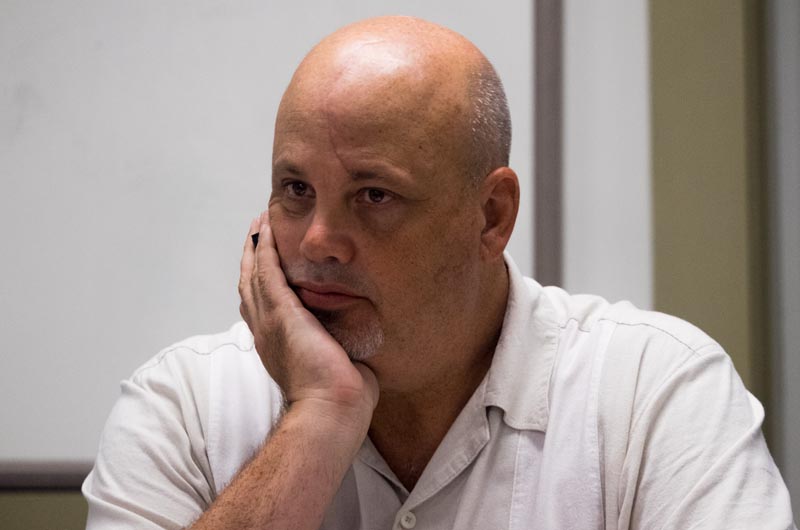Unable to agree on whether a 125-year-old house at the edge of the Edgartown Historic District qualifies as a historic property, the Martha’s Vineyard Commission on Thursday voted narrowly to review a building demolition proposal at 2 Beach street as a development of regional impact (DRI).
The 1,926-square-foot house, less than a block from the southern edge of the historic district, is thought to have been built in 1890, using portions of a large ice house that stood farther inland. Brooks and Falotico Associates of New Canaan, Conn., hope to replace the house with a slightly larger one that would occupy the same footprint, minus a small corner that extends into the town right of way.
The Edgartown planning board referred the project to the MVC in June.
An MVC staff report says the property is a “simple but not exceptional example of home construction in Edgartown from the period” and appears to retain its original form. A proposed expansion to the town historic district would include all of Beach street, which already lies within a historic area as defined by the MVC’s 2009 Island Plan.

Commissioners struggled Thursday to determine whether the property was in fact historic or simply old. Bricque Garber, assistant to the Edgartown historic district commission, said in an email to the MVC that the property was of “particular interest,” and urged the commission to conduct a public hearing. But she offered no other historical information about the house.
“It was our hope that they would have written something more substantive, that would have said, this is the historical significance of the building,” commissioner John Breckenridge said. The staff report mentions a book about the ice house by former Gazette publisher and editor Henry Beetle Hough, suggesting that it may have more information.
The Massachusetts Historical Commission also provided little guidance, saying only that the project area had “no recorded historic or archaeological resources” that would warrant an archaeological survey.
“We’ve been thrust into this role of deciding what’s historic and what’s not historic, and I need help with it,” commissioner Jim Vercruysse said at the meeting. “Who says it’s historic?”
“It’s an old building, so what,” said commissioner Rob Doyle. “Why not just tear it down?”
The two commissioners most familiar with the house argued that the DRI process was itself the problem. Clarence A.(Trip) Barnes 3rd, whose moving company has been through the house at least twice, said there was nothing “terribly significant” about it, and questioned the need for a DRI review. “Hopefully we can get this down to some sort of a science,” he said of the DRI standards and criteria, which are up for review this fall.
“The problem is the word historic,” said commissioner Lenny Jason, who is the Edgartown building inspector.
“We have decided to put this in our checklist for whatever reason,” he said. “A project comes before us, and we cannot determine that the house is in fact historic.” In the end Mr. Jason voted not to recommend the DRI review.
Other commissioners were more cautious.
“If we send this back to the town, without admitting that we’re ignoring the request of the Edgartown Historic Commission, then shame on us,” said commissioner Linda Sibley, who worried that without the MVC, the project could diminish the historic character of the street. “It could be Bauhaus clear glass and nobody could really say no,” she said.
The commissioners voted 6-5 in favor of conducting a DRI review.
In other business Thursday, MVC chairman Fred Hancock appointed a five-member subcommittee to review the commission’s DRI checklist, as required every two years. The newly-proposed checklist will go to all town planning boards and building inspectors, along with MVC members, for review before a public hearing this fall.
New MVC executive director Adam Turner gave his first director’s report, in which he announced his intention to review the entire Island Plan, which provided a 50-year outlook on issues such as energy, housing and transportation. He was in the process of developing score cards that would help evaluate the approximately 400 goals and policies in the plan and frame a discussion of amendments.
Goals that were deemed immediate when the plan was passed in 2009 will have first priority in the review process. “In some cases everything has been done, it’s been effective and the towns have all adopted,” Mr. Turner said. “And other things we haven’t done anything with.”

Mr. Turner is also working on a method to better rank historic properties that come before the commission. He said that scoring each property according to age, structure and other criteria would improve the current system, which relies on individual reports.
The commission also approved a new education center at Polly Hill Arboretum in West Tisbury, a DRI that involves replacing a 19th-century barn with a two-story building to house a botany lab and herbarium, along with offices and storage space.
Despite their enthusiastic support for the project, commissioners requested more information related to a planned archaeological survey, and alternatives to tearing the barn down.
Polly Hill curator Thomas Clark said the survey would involve several small test pits, with reports made to both Polly Hill and the MVC. Public Archaeology Lab of Pawtucket, R.I., would conduct further work as needed, he said. Contractor Tucker Hubbell argued that the site was no more likely to yield artifacts than a nearby parcel once owned by the Martha’s Vineyard Museum, where a 20,000-square-foot survey had revealed only a single arrowhead.
Mr. Clark assured commissioners that the barn served no purpose and would be unable to support the new facility. Mr. Hubbell added that portions of the barn, along with a smaller shack, could be reused.
Commissioners asked that the archaeological survey plan be submitted in writing, after which they would vote on the proposal.
But in response to concerns about a May 2016 grant deadline, commissioner Josh Goldstein moved not to send the project to the MVC land use planning committee, as is usually the case for DRIs, but to vote on it that evening. The motion failed, but when commissioners realized they would not have a quorum at the next LUPC meeting, they voted to have the applicants prepare the written plan on the spot so they could approve the DRI.
The applicants disappeared into another room, emerging later with copies of a handwritten archaeological evaluation plan. The commission easily approved the project, with Doug Sederholm, a Polly Hill board member, abstaining.








Comments (12)
Comments
Comment policy »